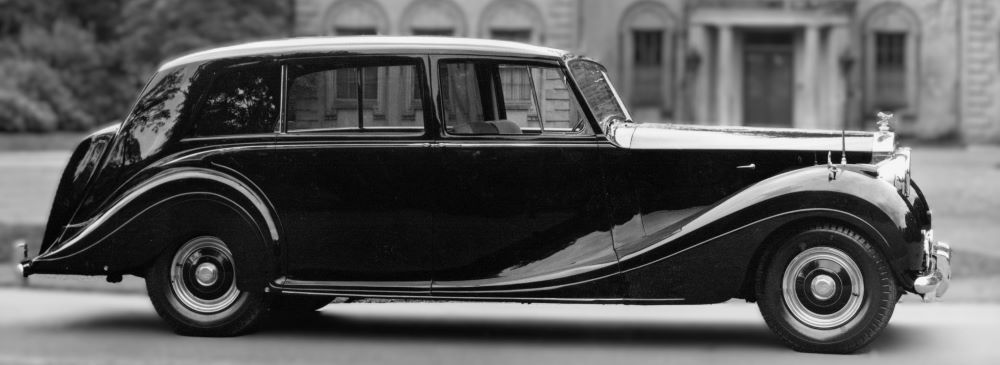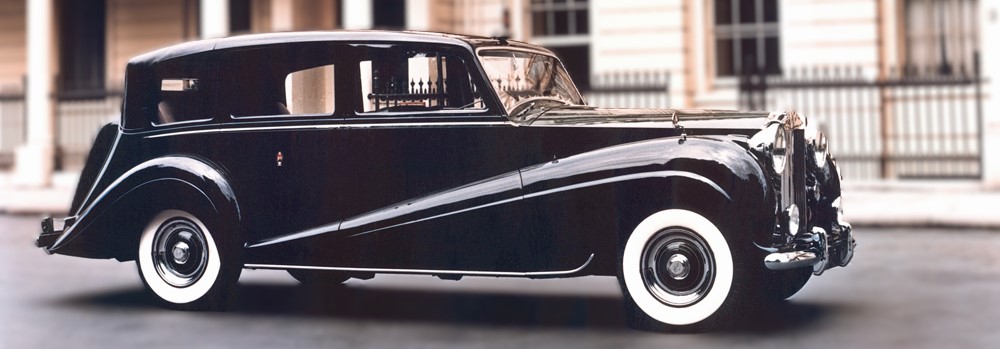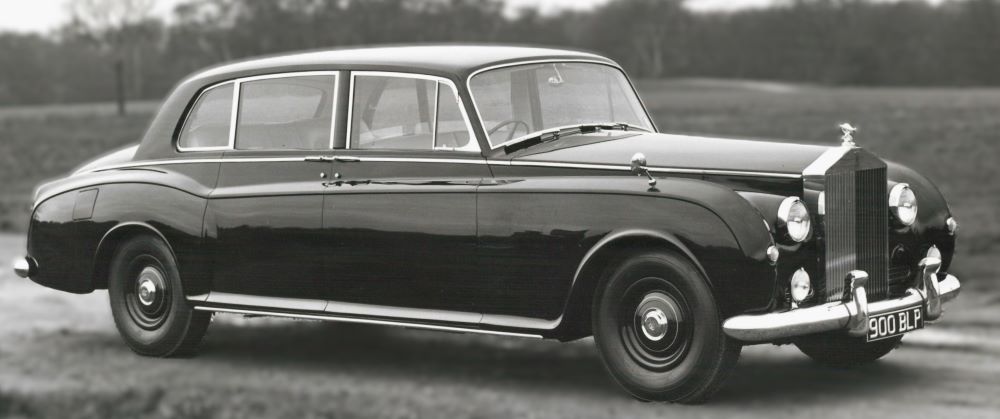In 1939, Rolls-Royce produced an experimental car, nicknamed ‘The Scalded Cat’. In later years, this car was often loaned to influential individuals, including HRH Prince Philip, Duke of Edinburgh. The Duke was so impressed that he persuaded Rolls-Royce to build him a more formal version; the marque obliged with the first Phantom IV, delivered in July 1950. The car remains on front-line (albeit reduced) duty at The Royal Mews, under its pre-delivery codename, Maharajah. Though originally intended as a one-off, 18 Phantom IV cars were completed: 17 were sumptuously appointed commissions for other royalty and heads of state; the other, somewhat bizarrely, was built as a pick-up truck for use by Rolls-Royce as transport and on-the-road component testing.

Rolls-Royce Phantom IV, 1950–1956
The Rolls-Royce Phantom IV is one of the rarest and most exclusive models ever produced by Rolls-Royce. Built on an extended chassis, providing a smooth and stable ride. The bodies were crafted by coachbuilders such as H.J. Mulliner, Park Ward, and Hooper, contributing to the car’s unique and exclusive nature. The interiors were exceptionally luxurious, featuring the finest materials, including high-quality leather, exotic wood veneers, and custom fittings tailored to the owner’s specifications.
The Phantom IV was exclusively offered to royalty, heads of state, and other high-profile figures. Notable owners included Queen Elizabeth II, the Duke of Edinburgh, the Aga Khan, and General Francisco Franco of Spain. Each Phantom IV was built to order, with bespoke designs and features catering to the specific needs and preferences of its elite owners.
Overview/Specifications
- Production Years: 1950 to 1956
- Total Produced: Only 18 units
- Assembly: Crewe, England
- Engine: 5.675 L straight-8 engine
- Transmission: 4-speed automatic transmission
- Body Style: Custom-built bodies by renowned coachbuilders, making each Phantom IV unique
- Wheelbase: 145 inches (3,683 mm)

In 1959, the marque launched Phantom V, equipped with its most up-to-date V8 engine. In 1967, the car underwent subtle technical changes that were deemed, at the very last minute, sufficient to justify its redesignation as Phantom VI.
Of the 832 total Rolls-Royce Phantom V’s built between 1959 and 1968, James Young made 217 bodies. Park Ward, owned by Rolls-Royce, made 607 bodies. In 1962, H. J. Mulliner & Co. was merged by Rolls-Royce with Park Ward to form Mulliner Park Ward. Prior to the merger, eight Phantom Vs had been made by H.J. Mulliner.
By 1968 the only true coachbuilder left in Britain was Rolls-Royce’s own in-house company, Mulliner Park Ward. These magnificent cars soldiered on through the mid-1980s, until production dwindled to a mere two or three cars a year, and finally ceased altogether in 1992.

Rolls-Royce Phantom V, 1959–1968
In 1959 the latest Phantom V was introduced to replace the Silver Wraith. The Phantom V provided a long-wheelbase chassis for specialized coachwork which incorporated chassis features and the powerful V8 engine of the Rolls-Royce Silver Cloud. The Z-bar location of the Silver Cloud back axle was replaced by a single radius rod on the Phantom V and the rear axle was mounted asymmetrically on the springs.
With the launching of the Phantom V, Rolls-Royce was offering a vehicle of the highest class, but not reserved solely for dignitaries, royalty and heads of state. Here was a Rolls-Royce for those successful in business and finance who were looking for an exceptional car providing convenience, incredible comfort and plenty of room. Although the first orders were placed by the royal court and dignitaries, the bulk of inquiries originated in industry or from private individuals.
Rolls-Royce assumed there would be many Phantom V orders for custom coachwork, but the cost and the fact so few firms now existed resulted in very few examples being ordered. James Young & Co. Ltd. of Bromley, Kent dated back to 1863 when James Young bought an existing carriage maker. Known for its quality-built, lightweight carriages, Young built its first car body in 1908. Business expanded over the decades and James Young bodies were fitted to Bentley, Bugatti, Hispano-Suiza, Alfa-Romeo, Isotta-Fraschini and of course Rolls-Royce chassis. Rolls-Royce dealer Jack Barclay purchased the firm in 1937. James Young coachbuilt bodies were offered until 1967, but the firm continued on to do body refinishing work.
James Young bodies designed for the Phantom V were known for prominent rear body lines. Of the bodies built, James Young was most praised for its stylish fastback coachwork.
The Rolls-Royce presented here features an older restoration that been meticulously preserved and as a result, the Phantom V remains in exquisite condition. Painted in a stunning Garnet and Silver Sand the paint scheme accentuates the fastback’s smooth, flowing lines. Whereas some Rolls-Royce and other luxury models of this period are covered in gaudy chrome, this stylish example wears its brightwork like jewelry.
Inside, the tan leather interior is tasteful, with deep maroon piping and the rich French walnut wood trim. The cushioned leather seating remains comfortable and inviting. Beautifully appointed with luxurious rear passenger cabinetry, plush maroon wool carpets and supple leather panels, this air conditioned environment provides a ride suitable for royalty. In fact, in 1960 a Phantom V was built for none other than Queen Elizabeth.
Under the hood the powerful V8 engine was restored, painted and detailed and has been well-maintained, as have all the other mechanicals.
Total production of the Rolls-Royce Phantom V lasted from 1959 to 1968 over which time just 832 of these hand-built luxury cars were built. This handsome limousine with its James Young-crafted fastback coachwork is a wonderful example of a luxury automobile rarely seen today.
A total of 16 State Landaulettes have been built since the body style was interoduced in 1965. five on Phantom V chassis and 11 on the Phantom VI chassis

You must be logged in to post a comment.